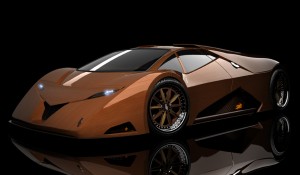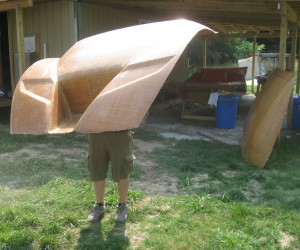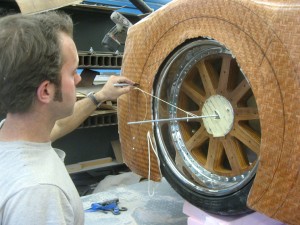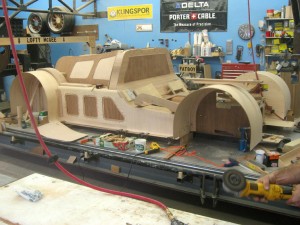
If wood is strong enough for a bridge and light enough for a speedboat or airplane wing, why not use it to build a high-performance supercar?
This sort of thinking must have kept Joe Harmon, an Industrial Design graduate student of North Carolina State University, up late at night, because that’s exactly what he set out to do for his graduate project: build a fully functional, supercharged automobile almost entirely out of wood.
Yep, wood.
But a jalopy this one sure ain’t. It’s everything you’d imagine a mid-engine concept car to be: sleek, ground-hugging, futuristic and—at least as Joe envisions it—incredibly fast.
I was lucky enough to see the Splinter Car more than a year ago at the International Woodworking Fair in Atlanta, when it was unveiled to a group of press people in the Delta/Porter-Cable booth. Since then it’s been on tour at a number of industry and school venues, including the AWFS Trade Show this past July in Las Vegas. You may have read about Joe’s Splinter Car in other publications or caught wind of it elsewhere, but we’d be remiss not to call attention to it directly in our blog. Here’s one ambitious project.
The Splinter is made of a mix of veneer composites and solid parts, depending on structural requirements. For we wood aficionados, here’s a very short hit list of included species: the body is eighth-inch-thick woven cherry veneer. Its leaf springs are laminated Osage orange. Other suspension components consist of hickory (tie rods), maple and aformosia veneer (control arms), as well as maple, ash and walnut (shock towers). The wheel wells are oak, and the starburst wheels are a combination of rotary-cut oak veneer, walnut and cherry. Of course what would a wooden car be without a wooden steering wheel—the Splinter’s is made of walnut burl, plywood and cherry. Epoxy and other adhesives hold it all together.
 Now, a supercharged race car can’t be entirely made of wood: it sports an intercooled and modified Cadillac Northstar V-8 engine. The transaxle is from a C5 Corvette, and other key suspension, steering and braking components are made of metal…some fabricated on site, some found elsewhere. But, the heart and soul of this car is wood, through and through, The powerplant is estimated to generate 600 horsepower, and Joe anticipates that it will propel this 2500-pound car more than 200 mph down the track. Pretty fast for wood, don’t you think?
Now, a supercharged race car can’t be entirely made of wood: it sports an intercooled and modified Cadillac Northstar V-8 engine. The transaxle is from a C5 Corvette, and other key suspension, steering and braking components are made of metal…some fabricated on site, some found elsewhere. But, the heart and soul of this car is wood, through and through, The powerplant is estimated to generate 600 horsepower, and Joe anticipates that it will propel this 2500-pound car more than 200 mph down the track. Pretty fast for wood, don’t you think?
Joe and a team of friends have built the car in a garage behind his North Carolina home. Well, really a small manufacturing facility, from the looks of it. The process of building the car has required Joe’s team to build a variety of looms, molds and specialized fabrication equipment. They’ve added industrial presses and machinery from other sources, rebuilding and revamping as needed. Delta/Porter-Cable has supplied many woodworking machines. And, the team has been assisted by more than two-dozen other industry sponsors to help make the Splinter a reality. No matter how “grass roots” the enterprise, this one has been a collegial and collaborative effort.
Joe says he didn’t set out to make a “green” statement here, nor is he advocating that we all drive wooden cars. The heart of this project began as an academic exercise and a way to explore materials and ideas. Along the way, Joe has built an engaging website that documents the car’s construction:
academic exercise and a way to explore materials and ideas. Along the way, Joe has built an engaging website that documents the car’s construction:
http://joeharmondesign.com/
Lots of video clips and photo galleries will take you along on road trips to find wood or machinery. See how the team weaves cherry veneer to make up body panels, and get an insider’s look at the shop and the car as it takes shape. There’s good sawdust and grease-monkey stuff here!
So, whether you’re passionate about wood, fast cars or both, here’s a great way to surf through a few lunch breaks sometime soon. Then drop Joe an e-mail and let him know what you think. I’m sure he’d appreciate it.
Catch you in the shop,
Chris Marshall, Field Editor





